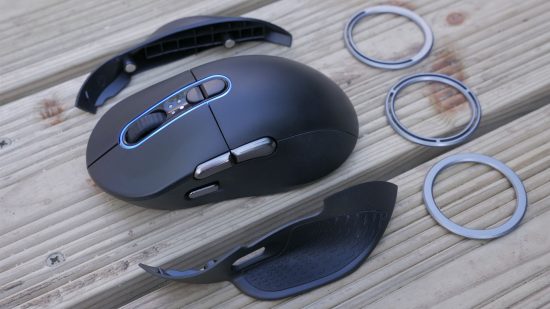Our Verdict
70%An intriguing modular design broadens the appeal of this modular wireless gaming mouse, but it still only has niche appeal.
The new Mountain Makalu Max wireless gaming mouse joins Mountain’s range of modular gaming peripherals such as its superb Mountain Everest Max and Everest 60 keyboards. However, while modularity can be a positive game changer for some devices, the Makalu Max modular wireless gaming mouse shows it isn’t always a route to the perfect product.
Mountain Makalu Max features
The Mountain Makalu Max follows the release of the simpler Mountain Makalu 67, which is a lightweight wired gaming mouse that isn’t modular. The Makalu Max retains the same shape but adds removable side panels that allow you to alter the shape of the mouse, plus it has a weights system for adjusting the mouse’s heft and the new model is wireless too. The new mouse also includes a USB-C port on its front so it can be used in both wired and wireless modes.
Also included is an extra button that sits under the thumb, which by default acts as a DPI sniper button for quickly lowering your mouse DPI when held down. On top of the mouse there are also DPI up and down buttons along with four LEDs for indicating which profile you have selected. These buttons join the standard selection of a scroll wheel and right, left, middle click (via the scroll wheel), back, and forward buttons.
Mountain Makalu Max design
The Makalu Max’s design is an interesting one, both in terms of its shape and its styling. Regarding the latter, the rounded front and matching lozenge-shaped ring of light around the scroll wheel hints at a clean-lined, simplistic style, but then the mouse shape isn’t symmetrical to match it and the default multi-colored rainbow effect on the lighting is distinctly cluttered looking, though the lighting choice can be changed in software. Likewise, the choice of silver for the side buttons disrupts the look.
As a piece of design to adorn your desk, the Makalu Max doesn’t quite hit the all-black coolness of the likes of the Razer DeathAdder nor the more utilitarian vibes of the Logitech G Pro X Superlight or mechanically intriguing hole-filled look of lightweight mice such as the Cooler Master MM711.
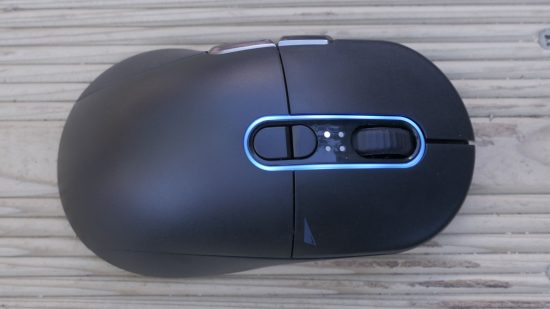
As for the shape, Mountain pitches the Makalu Max as being a mouse that’s suited to palm grip use, rather than fingertip or claw grip, with the interchangeable sides then adding even more support for your fingers and thumb for long desktop use – a bit like how the popular Logitech MX Master productivity mouse has a thumb skirt and wide area for your fingers.
That’s all well and good but as only the company’s second mouse and its first wireless mouse, it seems a bizarre choice to focus on that use case for a modular mouse rather than create one that starts off as, say, a lightweight fingertip grip design (that’s perhaps even ambidextrous like the modular-buttoned Logitech G Pro Wireless) then can be converted to a wider palm grip design.
With the default side plates attached, then, the mouse has a fairly conventional slightly scooped left side and a gently inward sloping (towards the top) right side. This configuration is the most like a typical ‘contoured’ gaming mouse shape, such as the Razer DeathAdder, but even here the contouring doesn’t quite feel ideal to us.
We found our thumb sliding towards the thumb button while the right side slopes too much such that your fingers slide up it too. The lack of a ridge to the right side of the right button means there’s nowhere to slightly rest your ring finger, either.
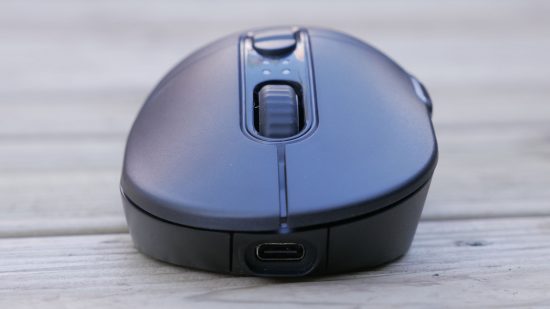
Exacerbating the problem is that the overall shape of the base of the mouse slopes inwards towards the front, so your fingers and thumb tend to slide forward on the mouse. This, in turn, causes the mouse to feel back-heavy when you try and lift it from the mousemat.
That’s more a concern for fingertip and claw grip users but even palm grip sometimes requires resetting the mouse position – even the much heavier and even more palm-grip-oriented MX Master is easier to pick up. The mouse could do with having a straighter right side, a more convex left side, a wider flared front, better weight distribution, or some combination of these.
Switch out the right side panel and you get a wide double-dimpled shelf for your ring and little fingers to rest on. It feels comfortable but limits your ability to grip and pick up the mouse even further.
The alternative left panel includes a rubber grip and adds a wide skirt under your thumb. It makes for a relaxing, smooth-gliding experience that is nice for more casual desktop use but further compromises gaming maneuverability.
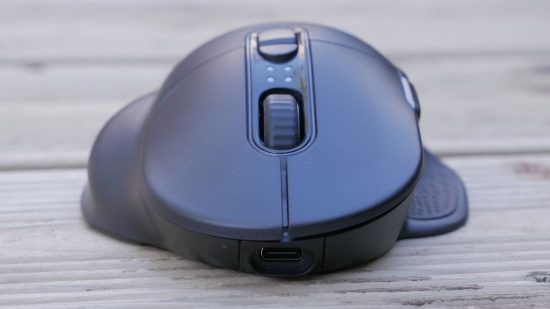
What really puts the nail in the coffin for any grip or movement style that requires regularly lifting and resetting the mouse, though, is the weight of this mouse. The Mountain Makalu Max weight is 99g bare, 109g (3.8oz) with the default sides, and 115g with the alternative sides. By modern standards that’s a chunky mouse. The Mountain Makalu 67 weighs 67g (2.4oz), for instance, while plenty of mice are lighter still. Then again, several mice are similarly heavy, such as the Corsair M65 Ultra or Roccat Kone XP, so it is ultimately personal preference.
You can even make the Makalu Max heavier by adding one of three included weight rings that weigh 6.6g, 8.4g, and 10.6g. The rings just push into place on the underside of the mouse.
While not everyone craves a lightweight mouse, the key point here is that considering this is the only mouse the company makes other than the wired-only Makalu 67, it’s an interesting choice to go the chunky-only route. The Makalu Max just seems to not really fit a function that we feel most gamers are craving.
A single mouse that can replace a lightweight fragging machine and a comfortable desktop rodent feels like a great idea. However, larger, palm-grip gaming mice are inherently already much more comfortable for desktop duties anyway, so it doesn’t feel like you’re gaining a huge amount with the interchangeable parts here.
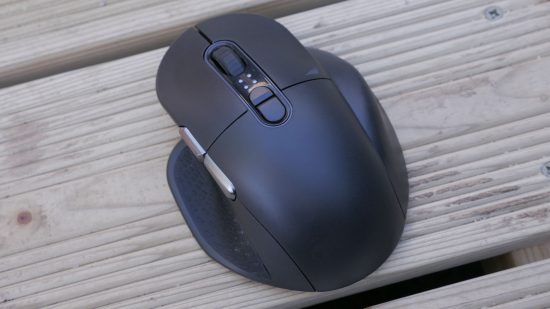
Mountain Makalu Max buttons
While we’re a little unconvinced by the Makalu Max’s shape, weight, and modular design philosophy, we’ve no complaints about the rest of its core features, starting with the buttons. The two main left and right buttons use high-quality Kailh GM 8.0 black switches that are rated to a massive 80 million clicks. They offer up a noticeably strong click response that makes for a much more positive feedback and sense of control than, say, the lightweight switches used on the Logitech G Pro X Superlight.
The other buttons don’t use the same class of switch (as is typical for any mouse) but all fall nicely to hand. The DPI buttons on the top are reasonably easy to reach – though not as effortless as single-button DPI switches such as on the Cooler Master MM711 – and crucially we didn’t find we hit them accidentally. We can’t say the same about the sniper button, though, which sometimes we brushed up against in the heat of battle.
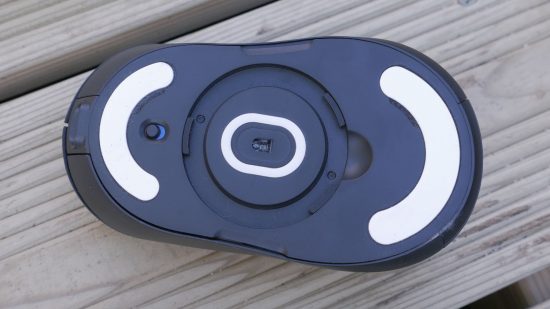
Mountain Makalu Max sensor
The Makalu Max uses a PixArt PAW3370 sensor with stats of 19000DPI maximum sensitivity, 50G acceleration, 400IPS max movement speed, 1-2mm lift-off distance, and a 0.5 percent error rate. It’s an excellent quality sensor also used in the Endgame Gear XM1r, for instance, and it performs as flawlessly as most modern optical mouse sensors. Whether you’re doing accurate tracing work in Photoshop or flinging the mouse across your mousemat in a fast-paced first-person-shooter, it keeps up with the lot.
Mountain Makalu Max battery life and wireless
This mouse can work in both wired and wireless modes, with a recessed USB-C port on the front allowing you to continue gaming while you charge. Despite being recessed, the opening is large enough to fit several random USB-C cables we tried, so you’re not stuck if you lose or break the original cable.
The wireless dongle has a USB-A port but a USB-C to USB-A adapter is provided for plugging the dongle into the end of the supplied USB-C cable, which is a pleasingly lightweight, flexible braided cable.
Battery life is rated at 80 hours, which largely tallies with the reported battery life from the mouse as we’ve used it over the course of a week. However, we need a little more time with the mouse to fully get a sense of how often it needs charging.
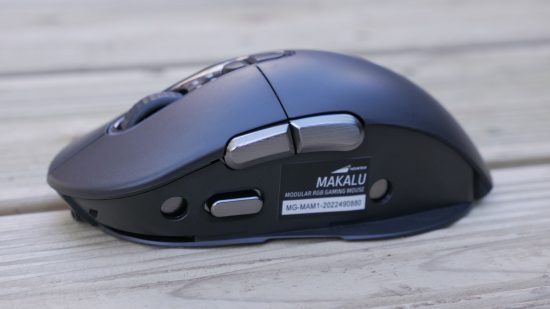
Mountain Makalu Max pros and cons
Pros:
- Versatile interchangeable side design
- Excellent sensor and tracking performance
- Easy wired/wireless use
- Reasonable value
Cons:
- Too heavy
- Shape pushes fingers forward
- Not suited to fingertip or claw grip
Mountain Makalu Max specs
The Mountain Makalu Max specs list is:
| Weight | 99g-115g depending on side panel, up to 125.6g with added weights |
| Dimensions (mm) | 58-70 (grip point-rear flare) x 126 x 43 (W x D x H) with default sides, 99 x 126 x 43 (W x D x H) with alternative sides |
| Sensor | PixArt PAW3370 – optical, 19,000 DPI, 50G acceleration, 400IPS |
| Buttons | 8 (left, right, middle, forward, back, 2 x top DPI, under thumb) |
| Cable | 1.8m USB-C, lightweight braided |
| Battery life | 80 hours |
| Extras | USB-A wireless dongle, USB-C to USB-A adapter, extra weight rings, alternative side panels |
Mountain Makalu Max price
The Mountain Makalu Max price is $80 (€80), which puts it mid-pack for wireless gaming mice.
Price: Expect to pay $80 (€80).
Mountain Makalu Max review conclusion
We’re big fans of Mountain’s general approach to creating modular gaming peripherals that give the user the ability to chop and change how they use their products to fit their needs. However, with the Makalu Max, we feel the company has slightly missed the mark.
The core abilities of the mouse are strong, with a good sensor, quality buttons, easy wired/wireless/charging functions, and the modularity does provide some options.
However, the interchangeable sides and optional weights don’t combine to offer a meaningful enough range of uses. The high base weight of the mouse means it can’t function as a lightweight mouse and the lack of a symmetrical shape option or left-handed layout means it isn’t suited to fans/users of those sorts of mice.
As such, despite all its options, this is a mouse only really suited to fans of heavy, large palm grip-oriented mice. It’s a decent option for those users but we’re not overly convinced it’s better than several non-modular alternatives. As for our preferred mice overall, you can find our recommendations in our best gaming mouse guide, which includes a range of mice to suit different budgets and user needs.
